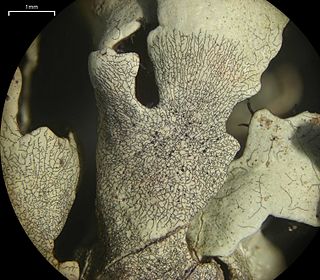
The Lecanoraceae are a family of lichenized fungi in the order Lecanorales. Species of this family have a widespread distribution.

The Psoraceae are a family of lichenized fungi in the order Lecanorales. The Austrian Botanist and Lichenologist Alexander Zahlbruckner first described the family in 1898. Species of this family have a widespread distribution.

Scoliciosporaceae is a family of lichen-forming fungi in the order Lecanorales. It contains two genera, the monotypic Umushamyces, and the type genus Scoliciosporum. The family was circumscribed by lichenologist Josef Hafellner in 1984.
Zwackhiomyces is a genus of lichenicolous fungi in the family Xanthopyreniaceae. The genus was circumscribed by Martin Grube and Josef Hafellner in 1990, with Zwackhiomyces coepulonus assigned as the type species.

Pycnora is a genus of fungi in the monotypic family Pycnoraceae. It contains three species. The genus was circumscribed by Josef Hafellner in 2001; the family was proposed by Mika Bendiksby and Einar Timdal in 2013.

Pyrrhospora is a genus of lichen-forming fungi in the family Lecanoraceae. The genus was circumscribed by German lichenologist Gustav Wilhelm Körber in 1855, with Pyrrhospora quernea assigned as the type species.
Llimoniella is a genus of fungi in the family Cordieritidaceae. The genus was circumscribed by lichenologists Josef Hafellner and Père Navarro-Rosinés in 1993.
Protomicarea is a genus of lichen-forming fungi in the family Psoraceae. The genus contains two species: Protomicarea limosa and Protomicarea alpestris. Protomicarea was circumscribed by lichenologist Josef Hafellner in 2001.

The Lecideaceae are a family of lichens in the order Lecideales.
Mycobilimbia is a genus of lichens in the family Lecideaceae.

Fuscidea is a genus of crustose lichens in the family Fuscideaceae. It has about 40 species. The genus was circumscribed in 1972 by lichenologists Volkmar Wirth and Antonín Vězda, with Fuscidea aggregatilis assigned as the type species.

Brigantiaea is a genus of lichen-forming fungi in the family Brigantiaeaceae. It was circumscribed by Italian botanist Vittore Benedetto Antonio Trevisan de Saint-Léon in 1853.
Pseudopyrenula is a genus of lichen-forming fungi in the family Trypetheliaceae.

Protoparmelia is a genus of lichenized fungi in the family Parmeliaceae. The genus has a widespread distribution, and contains 11 species. Protoparmelia was circumscribed by French lichenologist Maurice Choisy in 1929.

Lichenostigma is a genus of fungi. It includes several species which are lichenicolous.

The Tephromelataceae are a family of lichenized fungi in the order Lecanorales. The family was circumscribed by Austrian lichenologist Josef Hafellner in 1984. Tephromelataceae comprises the genera Tephromela, Calvitimela, Mycoblastus and Violella, which together constitute a well-supported monophyletic group.

Arthrorhaphis is a genus of lichen-forming fungi in the monotypic family Arthrorhaphidaceae. It has 13 species. The genus was circumscribed by Theodor Magnus Fries in 1860. The family was proposed by lichenologists Josef Poelt and Josef Hafellner in 1976. Species in this family have a widespread distribution in temperate and montane habitats. They grow symbiotically with green algae, or parasitically on other lichens. The family Arthrorhaphidaceae has an uncertain taxonomic placement in the class Lecanoromycetes; that is, it is incertae sedis with respect to ordinal placement.
Clypeococcum is a genus of lichenicolous fungi belonging to the family Polycoccaceae.
Eiglera is a genus of crustose lichens belonging to the family Eigleraceae. Eiglera species are found in Europe and Northern America.

Pseudosagedia is a genus of corticolous (bark-dwelling) lichens in the family Trichotheliaceae. It was first circumscribed as a section of genus Arthopyrenia by Swiss botanist Johannes Müller Argoviensis in 1862. Maurice Choisy elevated it to distinct generic status in 1949. Pseudosagedia was little used until, in 1995, Josef Hafellner and Klaus Kalb resurrected the genus to contain members of the Porina nitidula species group with the perithecial pigment called Pseudosagedia-violet and lacking setae.












